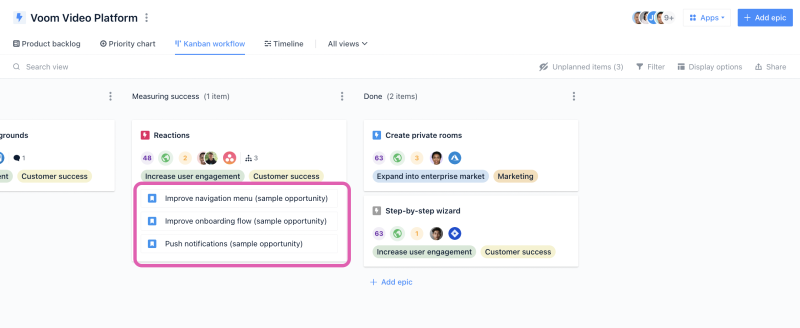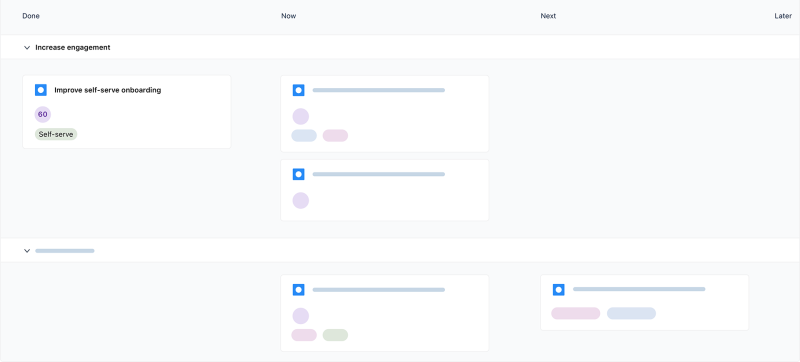The Ultimate Guide To Marketing Roadmaps – Templates, Examples, and Marketing Roadmaps

Cast your mind back just a few years, if you would, and come with us on a journey.
This is a journey to a time before we all had a portable GPS device in our pockets.
A time when personal touch screens were a thing of science fiction. And we all had those odd things called “keys” on our mobile phones.
In the pre-smartphone age, getting around wasn’t as easy as it is today.
No Google Maps, no instant GPS location, no Uber or Lyft. In fact, if you were a driver back then, you probably had a sat-nav system that you’d attach to your car windscreen — and it probably seemed like a magical device!
But sat nav systems were flawed. Very flawed.
Picture the scene: you’ve been on the road for a couple of hours, and your sat nav is telling you to stay true and keep going.
But what’s this?
You approach a roundabout… with five exits. This roundabout isn’t showing up on your sat nav’s map — it must be a new development.
You follow your nose, hoping for the best. But things get worse. The road you choose is not only taking you in the wrong direction, but it has traffic backing up, which might leave you stuck for hours.
The truth is, sat navs had very limited ability to adapt. They were an isolated system and, without a manual update, became almost useless over time.
These days, Google Maps can scan for potential delays, inform us of road diversions and help keep our journey on track.
Where a sat nav laid out a solid plan based on the evidence it had available, Google Maps knows that plans can, and usually do, need to change.
Now, you might wonder how all this ties into marketing and marketing plans. The underlying logic is the same: without a strategic plan which is responsive to change and can adapt to the conditions, your venture is almost certainly going to veer off course.
When it comes to marketing, having a well-plotted marketing roadmap can help keep your project focused and — perhaps more importantly — fully adaptable.
In this guide, we’ll explain exactly what a marketing roadmap is, why you should use one, the different types of marketing roadmap, and more.
Ready to hit the road? Then let’s begin.

What is a marketing roadmap?
When it comes to product development, the real secret sauce is planning and execution. After all, wrangling multiple development teams — often across time zones — is no easy feat.
For this reason, these teams will follow a product roadmap that helps them deliver a functional product on time and on spec.
So what about marketing that product? In today’s digital landscape, ‘set and forget’ just doesn’t cut it. And that’s where a marketing roadmap comes in handy.
In a nutshell, a marketing roadmap is a document that outlines the overall marketing strategy for a product over time.

It delineates key milestones and strategic goals, as well as providing timelines for hitting them. Roadmaps are often prioritized based on these timelines, and — crucially — they are ‘living’ documents.
Just as with our sat nav case study, being disconnected from real-world conditions is a disaster waiting to happen. Instead, it’s essential that a marketing roadmap can evolve and adapt as needed.
So, to summarize, your marketing roadmap should:
Visualize how you will achieve your strategic marketing goal.
Showcase the important marketing milestones within a project.
Give guidance and set priorities for the marketing team and other stakeholders.
Outline the targeted channels for the marketing efforts (content, PPC, SEO, PR, etc.)
Be adaptable to change based on real-world conditions.
Lastly, marketing roadmaps are not to be confused with project plans, where you map out where you need to go from A to B.
As a living document, your marketing roadmap has no ‘end’. It’s something you will continue to come back to for as long as your marketing activities continue.
What are the benefits of a marketing roadmap?
If you’re a marketer, you’ll already know that — at its core — marketing is all about telling a story.
But, unlike a printed novel, full-scale marketing campaigns are often created by dozens of individuals across multiple teams. So how can you make sure that everyone is following the same narrative? That’s the beauty of the marketing roadmap.
Need more convincing? Here are just three ways a marketing roadmap can help drive your product to real success:
A marketing roadmap visualizes the project for all key stakeholders. Meetings are all well and good, but there’s a limit to how much we can understand by simply talking about something. A well-designed marketing roadmap provides a visual representation of the project over time, so the whole team knows where they’re going — and why.
The marketing roadmap allows marketing teams to prioritize their tasks. Hopping back to our storytelling analogy again: there’s a reason why chapters are numbered. Certain tasks need to take place before others in order to reach the goal successfully — in product development speak, these are called ‘dependencies'. A marketing roadmap gives visibility of key dependencies and allows for re-prioritization if things change.
Finally, a marketing roadmap will help to align teams that are often siloed or otherwise disconnected. Telling that brand story isn’t possible if nobody’s talking to one another, so the marketing roadmap gives the whole team visibility of what everyone else is up to. This transparency also ensures no single area of the strategy is left unattended for too long.
If you’re a marketer who’s had difficulty sticking to a marketing plan, the solution may well lie in using a roadmap instead.
The reactive, organic nature of a marketing roadmap means that — even if things change unexpectedly — the high-level strategy responds in kind, and the whole team knows about it.
What’s more, you can all progress in the confidence that you’re working on the right priorities to get your campaigns to where they need to be.
Now that’s what we call teamwork!
The anatomy of a marketing roadmap
It should now be clear why marketing roadmaps are essential — but what do they actually look like?
Unlike a marketing or project plan, which is static documents, your roadmap needs to live and breathe, which is why it’s a better idea to build your roadmap on a platform that allows for quick reorganization.
Excel, for example, is a little too rigid.
Wherever you choose to build it, your marketing roadmap could take on a number of different formats, including:
Board view

If you’re a fan of swimlanes (not the ones which require a towel), Board View could be your go-to.
By breaking down tasks into what’s important now, in the short term, and further into the future, you can see exactly which ones need to be prioritized. Teams can use this view to align with others and ensure deliverables are being completed in a truly synchronized way.
Timeline view
With the Timeline View, teams can see exactly where their projects lie within the context of the whole project’s timeline.
This can highlight dependencies and overlaps, which will help further refine the overall strategy.
Types of marketing roadmaps
Okay, we’ve covered a lot so far. So let’s take a moment to recap.
We’ve looked at what marketing roadmaps are, why you might want to use one, and what they look like. One thing we haven’t explored just yet is exactly what you can use them for.
“Marketing” can be something of a nebulous term, so let’s sharpen the pencil a bit and focus on which specific activities you might want to track with a marketing roadmap. Whether you structure your marketing roadmap by year, quarter, or month, it’s the tasks themselves that make all the difference.
Digital marketing roadmap
While it is an umbrella term, digital marketing is at the heart of most marketing roadmaps today.
If you’re trying to balance email drip campaigns with Pay-Per-Click ad management, plus keep your social media following updated on a daily basis, it can be a real headache.
But with a digital marketing roadmap clearly detailing (and delegating) each task, you can bring some much-needed clarity to your digital marketing strategy.
Search Engine Optimization (SEO) roadmap
If you’ve ever dipped your toe into the world of SEO, you’ll know that it’s a long-tail game. It takes time to get good results, so having a vision of where you’re headed is absolutely essential.
With an SEO roadmap, you can do exactly that. Simply commit to plotting out your key SEO activities well ahead of time. That could be on-page or off-page optimizations, content creation, or backlink generation. In any case, your SEO roadmap will help you better understand the strategic value of your content efforts.
Inbound marketing roadmap
In the digital age, organic growth doesn’t just happen. Instead, you need a solid inbound marketing strategy and — more specifically — a content calendar.
An inbound marketing roadmap can help you to plan out the content you’ll publish over the year and into the future. Not only will this help you understand your organic growth, but it’ll also give you opportunities to see seasonal content opportunities (like Christmas or Valentine’s Day), which may result in a welcome lift.
You may also have several channels of inbound marketing happening at once, and your roadmap will hold centralized information about what�’s happening, where, and why.
Marketing roadmap examples
As we talked about earlier, your marketing campaigns should tell the story of your product or brand. So how will you actually structure this tale?
That’s the job of your marketing roadmap, and you’ve got quite a few options before you. Do you want to focus on the tasks themselves, or would you prefer to keep tight to the goals of those tasks?
This can be a little confusing, so some practical examples will definitely help. Here are three of our favorite marketing roadmap structures:
1. The category-based roadmap
One of the simplest ways to structure a roadmap is through the lens of the tasks themselves.
Each of these tasks will fall naturally within a category by which you can sort them. For example, backlink generation or guest blogging would fall into the “SEO” column, rewriting the homepage copy following a repositioning piece might be “Positioning,” and so on. By assigning tasks to their categories, you can get a solid overall view of your entire marketing journey.
2. The individual-based roadmap
At the end of the day, any marketing roadmap will succeed or fail based on the people driving it forward.
If understanding the team’s workload is important to you, you may want to consider structuring your marketing roadmap based on the individual team members. A view like this will allow teams to see not only the tasks they must complete but also understand what their colleagues are working on, too. This should increase accountability and engagement across the board.
3. The time-sensitive roadmap
There may be occasions when you’re up against the clock and need to get a project to the finish line faster. Funnily enough, in these cases, your marketing roadmap might actually become even more valuable because it’ll keep you focused on the schedule.
By setting up your view based on due dates, you’ll be able to see in a single glance exactly what needs prioritizing and when it’s due for delivery.
How to create a roadmap with airfocus
Creating a marketing roadmap with airfocus couldn’t be easier. You can start from scratch and become the master of your own marketing roadmap. Or, to save a bit of time, you could use our Marketing Plan and Prioritization Template. Here’s how it works.
1. First up, select the relevant template and apply it. Our marketing roadmap prioritization template was designed from the ground up to bring clarity and serenity to what can be a chaotic process. This prioritization framework is based on what matters most to your business, meaning you can focus on lead generation, brand awareness, or both. Even better, you can leverage both time and cost as a dimension to further refine and prioritize your tasks. The template also considers risk and how it may impact your decision-making.

2. Now it’s time to focus on you. Begin by adding your outstanding tasks to the template and setting factor scores for each one. You can also tweak the look and feel of the roadmap so that it fits your brand to a tee. ( you can also import your tasks from tools like Jira or Trello)
3. airfocus will look at the ratings you assigned, work its magic in the background, then assign a score to each individual task.
4. Once your tasks are added, it’s time for the fun part: choosing a view. As we discussed above, you can pick from item view, chart view, board view, gantt view or timeline view. This can change further down the line if you need.
5. Depending on the view you’ve chosen, you can use the sorting and filtering options to further refine the layout. Want to sort by project hours and cost? No problem. Or is business value what matters most? You can do that too. It’s totally flexible.
6. Now that you’ve picked the view which works for you, you’ll be able to shuffle your tasks and begin assigning them on the timeline. You can edit the duration for each task, set deadlines, and add any relevant milestones.
7. Now that all of your tasks are added and prioritized, it’s time to share them with the team. airfocus allows you to enable or disable views for stakeholders too, so if you want to keep everyone singing from the same hymn sheet, it’s a snap.
8. That’s all, folks! With this powerful template, streamlining your marketing project — and making it a success — has never been easier. Just don’t forget to keep your roadmap updated!
You should now have all the knowledge you need to become a fully-fledged marketing roadmap expert. Before the rubber hits the road, be sure to follow the steps above and try our ready-to-use marketing roadmap template.
After that, you and your team will be well on the road to success.
Marketing strategy vs a marketing plan vs marketing roadmap (+ examples)
If you ask your marketing team to build a marketing strategy, plan, and roadmap, you’re likely going to hear some grumbles. “Why do we need all three when our marketing strategy should cover everything?” is a common complaint, but it often comes from a place of misunderstanding.
Your team may be working from a foolproof marketing strategy; objectives are clearly laid out, with tangible benefits to the business. However, if they haven’t planned how they’ll achieve the objectives the strategy lays out, you may not see the results you expected.
To achieve the goals laid out in your marketing strategy, you need a plan and a timeframe. This is where the distinction between market strategy, marketing plan, and marketing roadmap comes into play.
For example…
Marketing strategy: A top-level view of key objectives for the business and product
Marketing plan: A list of activities you need to perform in order to meet those objectives
Marketing roadmap: A prioritized visualization of how you will perform the activities listed in the marketing plan and when you will perform them.
A marketing strategy should be guided by your business plan. It should encompass the vision you have for the product and the values of the business. The marketing strategy dictates your high-level objectives and is often a little ambitious.
Of course, you can’t achieve those objectives if you don’t plan how you will work towards them. The marketing plan offers a selection of activities that the team should perform to help achieve your goals. Essentially, it’s a to-do list.
Finally, marketing roadmaps clearly lay out the activities found in your marketing plan. To create the marketing roadmap, you need to assess and prioritize the marketing plan to build a schedule that maximizes the marketing plan’s effectiveness.
Marketing roadmap example (and how to create your own)
You’re likely familiar with roadmapping already — if not, make sure to download our free Roadmapping e-book — and you can use that knowledge to help shape your marketing roadmap. Of course, there are key distinctions to keep in mind.
What should a marketing roadmap include?
Items on your marketing roadmap should fall into one of three categories: analysis, execution, or evaluation. For example:
Analysis: Marketing teams start by researching target markets and audience demographics.
Execution: The team uses their research to plan and release targeted ad campaigns on digital platforms.
Evaluation: They look back on the campaigns to identify which worked well, which could be better, and which ideas should be shelved for the next project.
Teams can use a marketing plan template with swimlanes to categorize their initiatives into functional areas. This helps visualize the plan’s various elements and how the different activities will align with and support the team.
While it’s important to know what you should include, it’s equally important to know what not to include. A common mistake when using a marketing roadmap template is to include far more information than required. There’s no need for granular details such as specific adverts, channels and dates in a roadmap. If you need those details, you could create a tactical marketing roadmap that is specific to the initiative.
Can I create a marketing roadmap template in Excel?
Sure, you can… but you probably shouldn’t.
There’s no denying that Excel is a great tool, but it’s an ineffective tool when you know that priorities and timelines may change. For starters, it hasn’t been created with marketing activities or marketing roadmap templates in mind. This means there’s a lot of effort involved in getting the software to do what you want it to do.
Given that we have a wide range of purpose-built product management platforms available to us these days, it seems silly to keep relying on Excel. Using a platform like airfocus means you can quickly build a marketing roadmap and share them across your team, stakeholders, and users with ease.
Most product management platforms will offer a huge range of marketing roadmap examples and templates. This makes roadmapping even quicker and simpler, allowing teams to focus on building real value instead of wasting time with little things.
How to create a marketing roadmap
Businesses and brands need a well-defined marketing strategy in today's competitive market. Creating a marketing roadmap can help your team align and execute your marketing initiatives.
Follow these steps to build a great marketing roadmap.
Step 1: Identify your high-level goals
It’s easy to get distracted by day-to-day tasks and small team goals. But all marketing roadmaps need to focus on high-level goals to generate results. These goals will unite teams in the organization to work towards one primary objective.
All high-level goals should be specific, measurable, achievable, relevant, and time-bound (SMART). The big-picture goal should be large enough to break it into smaller milestones for your team.
Step 2: Break those goals down into milestones
When it’s time to start implementing strategies to achieve your high-level goals, you need specific milestones to target. For example, if your company goal is to increase revenue by 30%, highlight milestones that would achieve this goal.
Make all milestones clear and attainable to keep your team motivated. One example could be increasing SEO efforts to generate more organic traffic. More blog visitors result in more product conversions, resulting in higher revenue.
Try to increase blog traffic by 15% or aim for five organic conversions per month. Measurable goals bring better results.
Step 3: Determine a timeline for those milestones
You should set a timeline for each milestone to ensure your marketing initiatives stay on track. Your timeline should be realistic and achievable, considering your team's resources and other priorities. Remember, this can always be adjusted in the future too.
Step 4: Assign responsibilities
Assigning responsibilities ensures that everyone on the team knows their role in executing the marketing initiatives. It helps create accountability and ensures that each task is completed on time.
Every team member should feel like they can directly impact company performance and improve the chances of reaching the team’s high-level goal.
Structuring a marketing roadmap
Next, you can focus on structuring your roadmap. A visual roadmap is an effective strategy because it’s simple and easily understandable for team members. All company and project information can be highlighted and communicated in your visual roadmap.
This visual representation of the company's marketing strategy clearly outlines high-level goals, initiatives, timelines, and responsibilities for everyone in the organization. You can highlight current initiatives being implemented and future ones that have yet to be finalized.
The best visual roadmaps focus on clarity. Here are a few tips for proper structure and design.
Use color: Colored labels are your best friend. Use these labels to categorize tasks and indicate the current status of specific objectives. For example, red for a new task, yellow for a task in progress, and green for a completed task.
Make the design easy to read: Large, easy-to-read fonts will help your team members identify their initiatives.
Use roadmap software: Using dedicated software tools to create your roadmap is always smart. Dedicated tools make it easy to customize your marketing roadmaps to your needs and make it easy to share with stakeholders.
Use templates: Save time and use software templates. We love the outcome-based roadmap template and its powerful prioritization framework. It’s ready to use with priority charts, timelines, and a backlog view.
Marketing roadmap examples
There are several different types of marketing roadmaps you can use to convey your marketing plan and goals. Here are some marketing roadmap examples.
Visual roadmap
A visual roadmap uses colors to track progress and shows what channels are being used to do what, when each action is taking place, where progress is, and what the end goal is. Each initiative is clearly defined at all times.
Timeline roadmap
This roadmap highlights different strategy phases and can be used repeatedly with each new client. All initiatives are tracked in chronological order to keep the team organized. The process can be refined as you test it on multiple clients.
Cross channel roadmap
This roadmap coordinates marketing efforts across multiple channels. The roadmap should have multiple views to show what different teams are working on simultaneously. This includes the content, organic search, and social media teams for a digital marketing roadmap.
Responsibility-based task roadmap
This roadmap shows who is accountable for what and creates a collaborative approach where everyone can see everyone else's tasks. It’s a great way to track team progress.

Andrei Tiburca

Read also



Build great roadmaps

Experience the new way of doing product management




